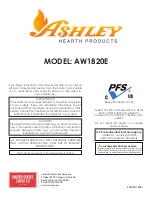
-8-
This appliance must be connected to a listed Stainless Steel Liner, that meets UL1777, which extends from the
collar to the chimney cap according to the specifications listed on the previous pages. Take into account the
chimney’s location to ensure it is not too close to neighbors or in a valley which may cause unhealthy or nuisance
conditions.
IMPORTANCE OF PROPER DRAFT
Draft is the force which moves air from the appliance up through the chimney. The amount of draft in your
chimney depends on the length of the chimney, local geography, nearby obstructions and other factors. Too
much draft may cause excessive temperatures in the appliance. Inadequate draft may cause backpuffing into
the room and “plugging” of the chimney. Inadequate draft will cause the appliance to leak smoke into the room
through appliance and chimney connector joints. An uncontrollable burn or excessive temperature indicates
excessive draft.
Chimneys perform two functions:
1. As a means of exhausting smoke and flue gases which are the result of fuel combustion.
2. The chimney provides “draft,” which allows oxygen to be continuously introduced into the appliance, so that
proper combustion is possible. This stove relies on natural draft to operate.
NOTICE: Always provide a source of fresh air into the room where the stove is located. Failure to do so may result
in air starvation of other fuel burning appliances and the possible development of hazardous conditions, fire, or
death.
Your appliance itself does not create draft. Draft is provided by the chimney. To help provide the required draft
there is a fresh air kit (4FAK) available for purchase from your local stove dealer. When installed properly the 4FAK
kit is designed to provide the draft needed for proper operation. To achieve proper draft your chimney must meet
the three minimum height requirements detailed in figure 8. A minimum draft of 0.05 w.c. (measured in water
column) is required for proper drafting to prevent back puffing, smoke spillage, and to maximize performance.
Gauges to measure draft are readily available at stove stores and are economical to rent or purchase. Factors
such as wind, barometric pressure, trees, terrain and chimney temperature can have an adverse effect on the
draft. The manufacturer cannot be held responsible for external factors leading to less than optimal drafting.
Should you have a problem with inadequate draft, you should contact a licensed heating and cooling contractor
for assistance in solving the problem.
IMPORTANT INSTALLATION POINTS
1. Size chimney flue to appliance collar. This stove requires a minimum 6” diameter flue.
2. Never connect this unit to a chimney serving another appliance.
3. The chimney must meet all minimum height requirements.
4. Never use a chimney to ventilate a cellar or basement.
Contact your local building authority for approved methods of installation and any necessary permits and/or
inspections.
MASONRY CHIMNEY
Before using an existing masonry chimney,
clean the chimney, inspect the flue liner,
and make any repairs needed to be sure
it is safe to use. As mentioned previously,
this appliance requires a continuous
stainless steel liner from the appliance
collar to the chimney cap. Make repairs
before attaching the stove. The connector
stove pipe and fittings you will need to
connect directly to a masonry chimney
are detailed in the installation instructions.
If the fireplace chimney must go through a
combustible wall before entering the main
chimney, consult a qualified mason or chimney dealer regarding proper materials that meet all local building
and fire authority codes. The installation must conform to local building and fire codes and latest edition of NFPA
211. If there is a cleanout opening in the base of the chimney, close it tightly.
Chimney Specifications
Summary of Contents for Ashley AW1820E
Page 19: ... 19 Notes ...









































